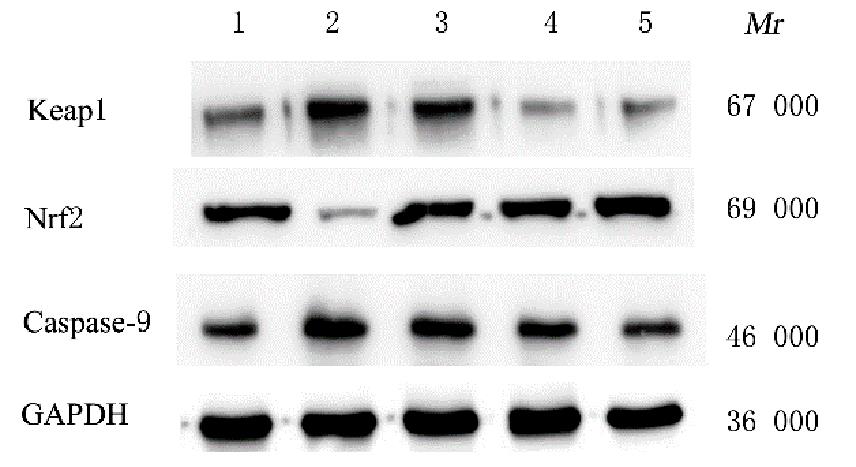| [1] |
Xueting CHI,Xiaowei HUANG,Fangyuan CHEN,Gaofeng ZHOU,Jinji WANG,Guangfu LYU,Zhe LIN,Qing GONG.
Improvement effect of velvet antler polypeptide in osteoporosis model rats and its effect on SIRT1/FOXO1 signaling pathway
[J]. Journal of Jilin University(Medicine Edition), 2024, 50(1): 120-127.
|
| [2] |
Weichen HOU,Guimei ZHANG,Shushi ZHANG.
Inhibitory effect of gingerone on apoptosis of HT22 cells by alleviation oxidative stress damage after OGD/R through activating Nrf2/HO-1 signaling pathway
[J]. Journal of Jilin University(Medicine Edition), 2024, 50(1): 97-105.
|
| [3] |
Wenting HUI,Tongtong SONG,Min HUANG,Xia CHEN.
Effect of hydrogel-based delivery of bFGF on function of NIH3T3 cells after oxygen-glucose deprivation
[J]. Journal of Jilin University(Medicine Edition), 2023, 49(6): 1484-1490.
|
| [4] |
Xiaolei XUE,Baomei XU.
Expression of Klotho protein in placenta exosomes in patients with pre-eclampsia and its effect on oxidative stress in vascular endothelial cells
[J]. Journal of Jilin University(Medicine Edition), 2023, 49(6): 1528-1538.
|
| [5] |
Hongli CUI,Siqi FAN,Wenfei GUAN,E MENG,Jiatong LIU,Xuetong SUN,Chunxu CAO,Lixin LIU,Yali QI,Fang FANG,Zhicheng WANG.
Inhibitory effect of irradiation enhanced by gallic acid-lecithin complex-induced oxidative stress on proliferation of A549 cells
[J]. Journal of Jilin University(Medicine Edition), 2023, 49(4): 941-946.
|
| [6] |
Yintao ZHAO, Yingying YANG, Xiangqin ZHANG, Lu ZHENG, Yawei XU, Haibo YANG, Yuan LIU.
Improvement effect of follistatin-like 1 on doxorubicin-induced acute myocardial injury in mice and its mechanism
[J]. Journal of Jilin University(Medicine Edition), 2023, 49(3): 565-572.
|
| [7] |
Jing GUAN,Shen HA,Hao YUAN,Ying CHEN,Pengju LIU,Zhi LIU,Shuang JIANG.
Protective effect of Modified Xiao-Xian-Xiong Decoction on liver injury in rats with type 2 diabete mellitus and its mechanism
[J]. Journal of Jilin University(Medicine Edition), 2023, 49(3): 608-616.
|
| [8] |
Chuan LIU,Huan LI,Dawei WANG.
Effects of Dendrobium huoshanense polysaccharide on oxidative stress and inflammation in brain tissue of mice with Parkinson’s disease
[J]. Journal of Jilin University(Medicine Edition), 2023, 49(1): 110-115.
|
| [9] |
Jun ZHU,Nan ZHOU,Deming LI.
Improvement effect of propofol postconditioning on focal cerebral ischemia-reperfusion injury in rats and its mechanism
[J]. Journal of Jilin University(Medicine Edition), 2023, 49(1): 46-54.
|
| [10] |
Yue CHENG,Keke NI,Dewang FU,Yang ZHANG,Hongyang TIAN,Huamao JIANG.
Improvement effect of tetramethylpyrazine on oxidative damage of kidney tissue in nephrolithiasis model rats
[J]. Journal of Jilin University(Medicine Edition), 2023, 49(1): 67-73.
|
| [11] |
Hao LI,Dongge LIU,Shuqi YAN,Shuping REN.
Improvement effect of 1,25(OH)2D3 combined with astragalus polysaccharide on insulin resistance of skeletal muscle cells in vitro and its mechanism
[J]. Journal of Jilin University(Medicine Edition), 2022, 48(6): 1411-1421.
|
| [12] |
Junxiu LIU,Jia ZHOU,Guangfu LYU,Yuchen WANG,Xuefeng ZHUANG,Jiarui ZHAO,Xiaowei HUANG,Ruili LI.
Protective effect of Shenhong Buxue Granule on vascular endothelium of mice with vascular endothelial dysfunction of Qi stagnation and blood stasis type and its mechanism
[J]. Journal of Jilin University(Medicine Edition), 2022, 48(6): 1437-1447.
|
| [13] |
Xiaochen HUANG,Hao LI,Baohua WANG,Kai LI.
Protective effect of lidocaine on PC12 cells in Parkinson’s disease model and its mechanism
[J]. Journal of Jilin University(Medicine Edition), 2022, 48(3): 638-647.
|
| [14] |
Yang ZHOU,Xuguang MI,Wenxing PU,Wentao WANG,Meng JING,Fankai MENG.
Ameliorative effect of melatonin on oxidative stress of human neuroblastoma SHSY5Y cells induced by hydrogen peroxide and its mechanism
[J]. Journal of Jilin University(Medicine Edition), 2022, 48(2): 340-347.
|
| [15] |
Leihua CUI,Yubo HOU,Chang SU,Minghe LI,Xin NIE.
Effect of N-acetylcysteine on apoptosis of MC3T3-E1 cells induced by nicotine and its mechanism
[J]. Journal of Jilin University(Medicine Edition), 2022, 48(1): 26-32.
|
 )
)





